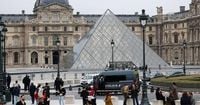Paris awoke on Sunday, October 19, 2025, to news that rippled across the art world and beyond: a lightning-fast heist at the Louvre Museum had stripped the iconic Apollo Gallery of eight priceless French crown jewels. The loot, worth more than $102 million (88 million euros), included some of the most storied artifacts of France’s royal past. According to Paris Public Prosecutor Laure Beccuau, who spoke to RTL radio on Tuesday, the theft’s economic impact is immense, yet it is the historical loss that truly stings. “It is important to remember that this damage is an economic damage, but it is nothing compared to the historical damage caused by this theft,” Beccuau stated, as reported by Reuters.
The brazen caper unfolded in broad daylight. Four masked thieves, disguised as construction workers, used a construction lift to reach a second-floor window of the Louvre. Armed with an angle grinder, they sliced through the glass and entered the Apollo Gallery, setting off an alarm—though it only alerted guards focused on visitor safety. Within seven minutes, the criminals had seized their glittering quarry and fled the scene on scooters, leaving behind shocked visitors and a gaping hole in France’s cultural patrimony.
The stolen treasures read like a roll call of imperial grandeur. Among them was a diamond and sapphire tiara that once graced the head of Queen Marie-Amélie, alongside a sapphire necklace and earrings. Also missing are an emerald necklace and earrings belonging to Marie-Louise, Napoleon’s second wife, a reliquary brooch designed to hold religious relics, and a tiara and bodice knot owned by Empress Eugénie. The thieves also targeted the crown of Empress Eugénie, a dazzling creation of gold, diamonds, and emeralds. Yet in their haste, they dropped this particular artifact during their getaway—a small mercy in an otherwise devastating loss, as detailed by AFP and Reuters.
For Parisian tour guide Anya Firestone, the theft struck a deeply personal chord. Firestone, a native New Yorker who has made the French capital her home, has led countless tours through the Apollo Gallery. The stolen jewels, she explained to The New York Times, were central to her storytelling, helping visitors trace France’s journey from monarchy to empire to republic. Her favorite piece, a bow-shaped tasseled brooch set with 2,438 diamonds and crafted for Empress Eugénie, was featured at the 1855 Exposition Universelle. “I had a deep knot in my stomach in the shape of the empress’s diamond bow corsage,” Firestone confessed, recalling her reaction to the news.
The brooch’s history is as dramatic as its design. Auctioned off by the French government in 1887 in an effort to “erase royal ties,” the piece was reacquired by the Louvre in 2008 after it was nearly sold at Christie’s. Now, its fate is uncertain, along with the other jewels—each one a tangible echo of France’s shifting political tides. Firestone lamented, “For people interested in fashion and in jewelry, I will never skip that room,” describing the Apollo Gallery’s displays as “the last glittering echo of France’s monarchy as it transitioned from kings to empires and into something else.”
The details of the heist itself have only deepened public fascination. Footage from inside the Louvre, shared by X/BFMTV, shows one of the criminals—calm as can be—cutting through a glass case in full view of visitors. The thieves, described by police as a “commando of four people,” attempted to set fire to their mobile ladder before escaping, perhaps in a bid to destroy evidence. In their rush, they left behind not only the imperial crown but also a motorcycle helmet and a glove. These items, now in the hands of investigators, are being examined for DNA traces. “Four people have been identified as being present at the scene,” Beccuau confirmed, adding, “We can quite imagine that around them there were a whole bunch of teams who helped them carry out this theft.”
Authorities have mobilized an impressive response. About 100 investigators are now hunting for the perpetrators, sifting through forensic evidence and combing Paris for leads. The Louvre Museum itself has been closed since the theft, with police officers and dogs patrolling the perimeter. The closure has left the city’s tourism industry—already a cornerstone of the Parisian economy—reeling from both the loss of the jewels and the temporary absence of one of its most beloved attractions.
Speculation abounds regarding the fate of the jewels. Experts, cited by AFP, fear that the artifacts may be dismantled, their gems sold off piecemeal on the black market. Yet Beccuau remains hopeful that the thieves will think twice before destroying such irreplaceable items. “The criminals won’t earn 88 million euros if they had the very bad idea of unscrewing these jewels and melting them down,” she warned on RTL radio. “So we can perhaps hope that they’ll think about it and won’t destroy these jewels without reason.” Firestone, too, clings to hope: “I like to think there’s a chance of recovery,” she mused, half-jokingly invoking the legendary Pink Panther and James Bond as ideal investigators for the case.
The theft’s cultural resonance has already begun to reshape the public’s relationship with the Apollo Gallery. Firestone noted that after the 1911 theft of the Mona Lisa, visitors flocked to the Louvre not just to see the masterpiece, but to experience the space it left behind. “When the Mona Lisa was stolen from the Louvre in 1911, people didn’t stop coming,” she observed. “They came to see the space she left behind.” She expects a similar phenomenon in the wake of this latest heist: “I’d approach the jewel theft in the same way. I see this loss as entering the jewels’ story rather than ending it.”
As the investigation unfolds, the broader significance of the crime becomes clear. The jewels were more than mere adornments; they were symbols of France’s complex history, each piece a chapter in the nation’s ongoing narrative. Their loss is not just a blow to the Louvre or to France, but to anyone who cherishes the world’s shared cultural heritage.
For now, Paris waits—anxious, resilient, and perhaps a little more determined to protect the glittering legacies of its past.





